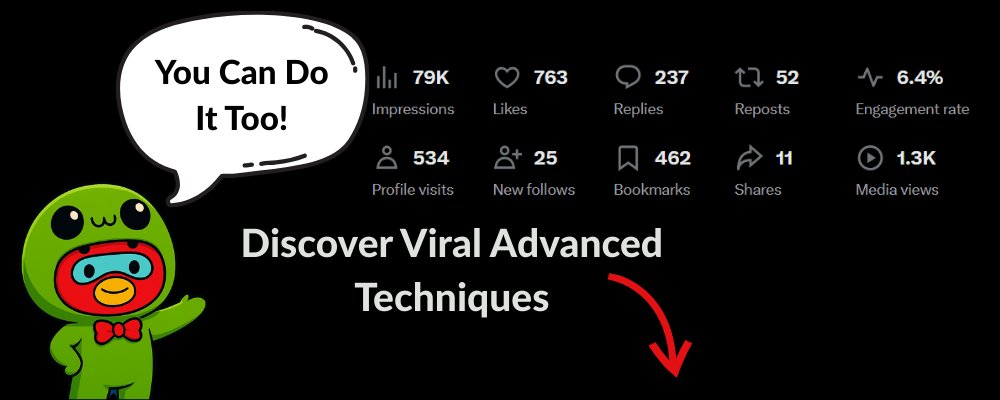The Hidden Psychology Behind Viral Content (Most Creators Get This Wrong)
Controversial techniques that generated 23% engagement rates! Get the exact frameworks, AI prompts, and psychology patterns from real case studies.
1. Introduction: The 70% Problem
Here's a fact that'll make you uncomfortable: 70% of creators who go viral once never repeat it.
They stumble into success, get a dopamine hit from the notifications, then spend months chasing that high with content that barely breaks double-digit engagement.
I know because I was one of them.
The best part? Most creators are doing the exact opposite of what actually works.
This isn't another "how to go viral" guide. This is a forensic analysis of what happens in the 2.3 seconds between someone seeing your content and deciding whether to scroll past or stop everything to engage.
⚠️ Warning
Some of these techniques are controversial. One involved deliberately posting fake information (with a reveal). Another required analyzing why people share confusion more than clarity.
If you're looking for safe, vanilla advice, this isn't for you.
2. The Viral Autopsy: Case Studies
"Crisis + Authority" Formula (78,400 Views)
The Kaito update killed 70% of creators' leaderboard positions 💀
I analyzed hundreds of accounts
Checked dozens of leaderboards
Found the thresholds
What I'm about to share will put you ahead of 99% who are still guessing.
Ready to reclaim your spot? 1/🧵 Pawnie (@Pawnie_) August 12, 2025
The Numbers:
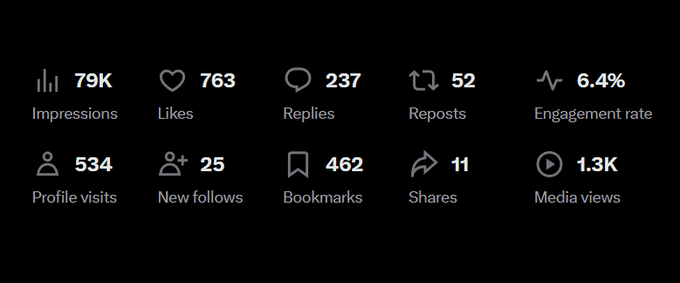
Why It Exploded:
Hook Engineering
The opening line combines three viral elements:
- Specific crisis ("killed 70%")
- Concrete data (not "many" but "70%")
- Visual impact (💀 emoji amplifies the "death" metaphor)
Authority Stacking
Three lines of credibility building:
- "analyzed hundreds of accounts" (research volume)
- "checked dozens of leaderboards" (thoroughness)
- "found the thresholds" (exclusive discovery)
Promise Hierarchy
Escalating value propositions:
- Level 1: Information ("what I'm about to share")
- Level 2: Competitive advantage ("ahead of 99%")
- Level 3: Problem solution ("reclaim your spot")
The Psychology: This hit three core human drivers: loss aversion (fear of losing position), information scarcity (exclusive thresholds), and social proof (hundreds of accounts analyzed).
"Confusion Marketing" Strategy (54,900 Views, 210 Shares)
KAITO UPDATE JUST DROPPED 🚨
but broooo 😭 Pawnie (@Pawnie_) August 8, 2025
The Numbers:
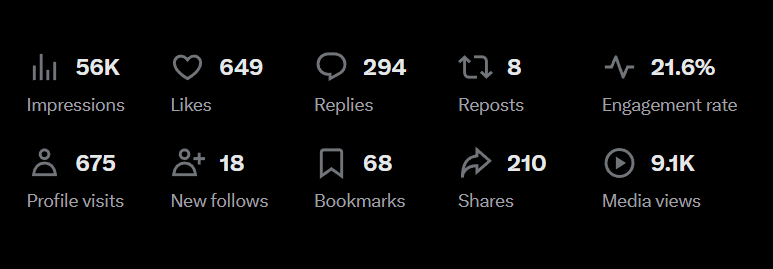
The Secret Weapon: Professional Fake Interfaces
This wasn't just text - it included pixel-perfect fake UI mockups of Kaito's interface showing absurd but believable features:
- "Be cool" ✓ checkbox
- "Have friends" ✓ checkbox
- "Talk about a project once" ✓ requirement
Why It Went Nuclear:
Initial Believability + Confusion Loop:
- Shock ("New update!") - Everyone was waiting for this
- Verification behavior (people checking if real)
- Realization (it's obviously fake when you look closer)
- Appreciation for the quality of the fake
- Sharing ("look who fell for this" behavior)
Community Sorting:
Created two engagement groups:
- Smart spotters: "Obviously fake lol"
- Confused checkers: "Wait is this real?"
Both groups commented and shared extensively.
Key Insight: People share confusion more readily than clarity. The 210 shares (vs 0-8 on other posts) prove this.
"Vulnerability + Value" Combo (20,300 Views)
I just earned my first Kaito Badge 😭 Pawnie (@Pawnie_) August 7, 2025
The Numbers:

The Psychology:
Achievement + Discrepancy: The crying emoji breaks the pattern. What looks like a celebration of earning a badge turns out to be a sad truth.
Here it is again a badge that seems real at first, but ends up mocking the creator's fate 😅
Classic entertaining content that fits the context perfectly (since badges for Kaito Capital Launchpad participants appeared at that time).
Strategic Humility:
"I'm not inner circle, but if you hit follow, maybe I can become one. Worth testing?"
This works because:
- Underdog positioning (not inner circle)
- Collaborative journey (maybe I can become one)
- Low-pressure ask (worth testing?)
Value-First Approach:
Before asking for follows, provided valuable resource:
"Check out @Web3Lists_ ! There you will find 160+ lists related to CT, InfoFi leaderboards"
"Research Tease" Technique (14,200 Views)
Been digging into Kaito leaderboards all morning.
Building lists = having a database of everyone who's ever hit top 100
Shocking facts:
👉 Half of top 100 creators vanished from most boards
👉 Some with 1k—5k followers are on 10+ boards
👉 Yaps > Smart Followers Pawnie (@Pawnie_) August 11, 2025
The Numbers:

The Strategy:
- Work-in-Progress Vulnerability: "Been digging... all morning" shows the effort happening in real-time
- Value Positioning: "database of everyone" positions the creator as sitting on valuable data
- Fact Delivery System: "Shocking facts" with bullet points creates scannable but impactful information
- Future Hook: "More tomorrow in the thread: 'How to get back on the Kaito leaderboards?'"
Why It Worked: People love behind-the-scenes access to research processes. It makes them feel like insiders.
"Believable Fake" Psychology (6,600 Views, 23% Engagement)
You can't follow me if you have fewer than 2500 followers.
BTW. Did you know that such a feature exists on X? Pawnie (@Pawnie_) August 19, 2025
The Numbers:
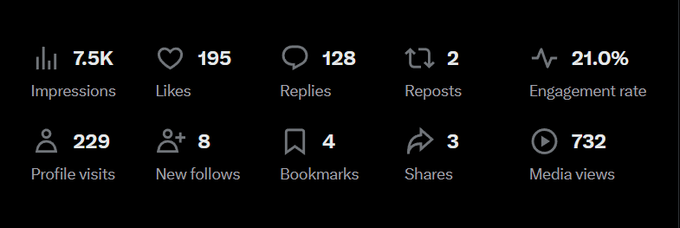
The Genius: Professional fake X interface showing follower restrictions
Psychological Triggers:
- Social hierarchy anxiety (follower count matters)
- Platform speculation (sounds like something X might add)
- FOMO trigger (am I eligible to follow?)
Here's a group of people saying, "I'm checking." "I can follow you" "It's not working" ...
The Reveal: Follow-up video showing it's fake.
Why 23% Engagement: Short content + high emotional reaction = dense engagement.
"Anti-Content" Satire (4,800 Views)
How to disappear from Kaito Leaderboards?
Guide for Big Retarded KOLs
🧵/69 Pawnie (@Pawnie_) August 18, 2025
The Numbers:
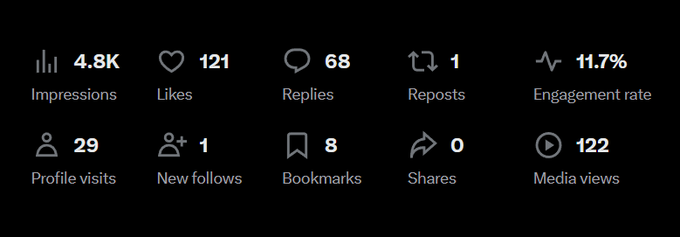
The Anti-Pattern:
- Promised 69 tweets
- Delivered 2
- Called it "completely useless threads"
It starts out as a serious thread, but obvious shitpost, because 69 is the "magic" number.
Why It Worked:
Here I take a jab at KOLs complaining that they're listed on multiple Kaito leaderboards for projects they never even wrote about. Once again, it's a graphic that looks believable but carries the obvious funny twist of "I'm retarded".
The comments range from praising the idea, to mocking the length of the thread, to joking about the retarded bit.
"Controversial Data" Framework (4,300 Views, 22.2% Engagement)
Already know why Kaito favors Korea and China.
You don't negotiate with terr... DATA!
My global regional research results 👇
(what does this mean for English CT?)
🧵/13 Pawnie (@Pawnie_) August 15, 2025
The Numbers:
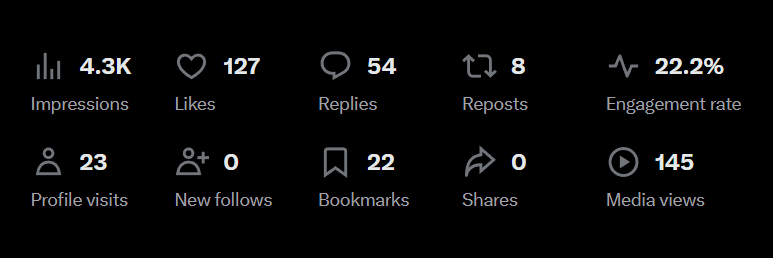
The Strategy:
- Controversial Setup: "favors Korea and China" addresses community complaints
- Data Defense: "cold, hard market reality" with specific statistics:
- "Asia controls 36.2% of global crypto trading volume"
- "$39 TRILLION annually"
- Underdog Appeal: Highlighted ignored regions with big numbers:
- "Latin America: $415 BILLION in volume"
- "Nigeria alone pushing $244B"
- "Where are they on Kaito leaderboards? NOWHERE!"
Why High Engagement: Controversial but defendable positions always drive discussion.
"Righteous Drama" Strategy (30K Views, 11.7% Engagement)
Don't steal content ⛔
(especially on Sunday)
I don't want to start drama, but...
this needs to be said 🧵 Pawnie (@Pawnie_) September 8, 2025
The Numbers:

The Drama Psychology:
Moral Authority Positioning: The opening creates a perfect storm of viral elements:
- Reluctant warrior stance ("I don't want to start drama, but...")
- Community service framing ("this needs to be said")
- Day-specific targeting ("especially on Sunday" - A reference to Sunday as a holy day, on which one should especially refrain from doing bad things)
Triple Engagement Trigger System:
- Justice Seekers: People who've experienced content theft rally behind the cause
- Drama Watchers: Those who enjoy conflict and want to see how it unfolds
- Knowledge Seekers: Creators learning about copyright and attribution
Strategic Vulnerability:
The thread balances authority with relatability:
- Legal expertise (Berne Convention references)
- Personal experience ("I've had several situations where...")
- Community examples (referencing @AlexFinnX case)
Why This Format Works: Educational wrapper prevents pure drama backlash. Solution-oriented ending maintains positive brand perception.
"Visual Loop" Technique (7.7K Views, 18.4% Engagement)
InfoFi wasn't supposed to look like this 😭 Pawnie (@Pawnie_) September 7, 2025
The Numbers:

The Visual Psychology:
Incomplete Information Strategy: The text creates an open loop that forces interaction:
- Emotional hook (😭 emoji suggests disappointment/concern)
- Vague statement requires clicking the image for context
- Industry reference (InfoFi) targets specific community
Controlled Complexity Infographic:
- Simple enough to understand quickly
- Detailed enough to require zooming/clicking
- Arrow-guided flow prevents cognitive overload
- Controversial but agreeable stance (most will nod along)
The Click Behavior Loop:
- Initial curiosity from cryptic text
- Image engagement (click/zoom to read details)
- Opinion formation while studying the diagram
- Comment trigger (agree/disagree with the flow shown)
Why High Engagement Density: Short, punchy content with visual complexity creates concentrated interaction. People spend more time processing, leading to stronger emotional reactions and higher comment rates.
"Fake Achievement" Controversy (High Engagement, Mixed Reactions)
I finally Made $30k from Openledger airdrop.
Biggest airdrop I got till date
Thankyou web3.
Now I can relax ALITA✨ (@AlitaIntel) September 8, 2025
The Achievement Bait Strategy:
Triple Community Reaction Generator:
- Congratulators: "Amazing, well done!"
- Investigators: "How did you get so much when others got pennies?"
- Skeptics/Comedians: "This is fake/hilarious"
Fake Achievement Psychology:
- FOMO trigger (others want similar success)
- Unfairness perception (why them and not me?)
- Verification behavior (people check if real)
- Community sorting (who falls for it vs. who spots it)
The Controversy Sweet Spot:
Perfect balance between believable and suspicious:
- Real platform reference (Openledger was distributing)
- Realistic but high amount ($30k - possible but rare)
- Community context (during actual airdrop season)
Strategic Risk Management:
Unlike pure scam attempts, this works because:
- Creator's known personality (community expects humor)
- No harmful intent (not stealing or promoting scams)
- Entertainment value (people enjoy the joke once revealed)
Key Insight: Fake achievement content works when the community is "in on it" to some degree. The engagement comes from people playing along with the performance rather than genuine deception.
3. The Viral DNA: Core Psychology Patterns
After dissecting these posts, I found 5 consistent psychological patterns that turn content from scroll-past to stop-everything-and-engage.
Pattern #1: Multi-Layer Hook Engineering
Viral hooks aren't single-element. They stack multiple psychological triggers:
Layer 1: Attention Interrupt
- Specific numbers (78,400 not "many")
- Emotional words ("killed," "shocking," "crisis")
- Visual elements (💀, 🚨, emojis)
Layer 2: Authority Signal
- Research claims ("analyzed hundreds")
- Exclusive access ("thresholds nobody knows")
- Expertise demonstration (fake interface skills)
Layer 3: Value Promise
- Competitive advantage ("ahead of 99%")
- Problem solution ("reclaim your spot")
- Exclusive information ("you won't find this anywhere")
The Formula
[Specific Crisis/Opportunity] + [Research Authority] + [Exclusive Solution] = Viral Hook
Pattern #2: Community Psychology Exploitation
Successful viral content creates two distinct audience groups:
- Group A: The Informed (spots patterns, appreciates technique)
- Group B: The Confused (needs explanation, asks questions)
Both groups engage heavily but for different reasons:
- Group A comments to show their sophistication
- Group B comments to get clarification
- Both groups share (Group A: "look at this clever thing", Group B: "help me understand this")
The Viral Sweet Spot: Content sophisticated enough for Group A to appreciate but accessible enough for Group B to engage with.
Pattern #3: Fake-to-Real Credibility Building
The most counter-intuitive finding: Posting obviously fake content (with reveals) actually builds trust.
The Psychology:
- Initial confusion creates high engagement
- Transparent reveal demonstrates honesty
- Quality of fake shows skill/effort
- Community in-joke builds belonging
This works because: Most creators hide their techniques. Showing the "trick" builds authority while maintaining approachability.
4. Advanced Techniques (The Ones Nobody Talks About)
Technique #1: Professional Interface Fakery
What It Is: Creating pixel-perfect fake interfaces of real platforms.
Why It Works:
- Initial believability creates engagement spike
- Quality demonstration shows technical skills
- Community verification drives discussion
- Meme potential creates shareable moments
Execution Requirements:
- Design skills (or tools like Figma)
- Platform knowledge (UI patterns, fonts, spacing)
- Community understanding (what's believable vs obvious fake)
- OR Know how to use AI (Me)
Risk Management: Always reveal it's fake. The transparency builds trust.
Technique #2: Confusion Marketing
The Strategy: Deliberately create confusion that resolves into value.
The Pattern:
- Post confusing content (fake update, contradictory information)
- Let community verify/discuss (engagement spike)
- Provide clarification (builds authority)
- Deliver actual value (maintains trust)
Why It Works: Confusion creates cognitive tension that demands resolution. People engage to resolve the tension.
Technique #3: Data + Emotion Fusion
The Strategy: Combine hard data with emotional storytelling.
Formula:
[Shocking Statistics] + [Personal Impact Story] + [Community Implication] = Viral Data Content
Example:
- "36.2% of crypto trading happens in Asia" (data)
- "+ that's why your account can't compete" (emotional impact)
- "+ here's what the community should do" (action item)
5. The Framework: Viral Content Architecture
Based on the analysis, here's the 6-Phase Viral Content Creation System:
Phase 1: Hook Engineering (30% of viral success)
Multi-Layer Hook Construction:
- Attention Layer:
- Specific numbers over general claims
- Emotional trigger words (killed, shocking, crisis)
- Visual elements (emojis, caps, formatting)
- Authority Layer:
- Research credentials (analyzed X accounts)
- Exclusive access claims (data nobody has)
- Expertise signals (technical knowledge)
- Value Layer:
- Competitive advantage promises
- Problem solution previews
- Exclusive information access
Hook Testing Framework:
- Does it stop scrolling in 0.5 seconds?
- Does it create immediate curiosity?
- Does it promise specific value?
- Does it position you as the solution source?
Phase 2: Community Psychology Mapping (25% of viral success)
Audience Segmentation:
- Group A: Sophisticated, spots techniques, appreciates craft
- Group B: Learning, needs explanations, asks questions
- Group C: Skeptics, challenges claims, requires proof
Content Calibration:
- Complex enough for Group A to appreciate
- Accessible enough for Group B to engage
- Defensible enough to handle Group C criticism
Phase 3: Engagement Mechanics Design (20% of viral success)
Discussion Triggers:
- Controversial but defendable opinions
- Questions that require personal experience to answer
- Community challenges ("tag the KOL who...", "send this to")
Sharing Triggers:
- Quotable one-liners
- Surprising statistics
- Useful frameworks people want to save
Comment Triggers:
- Questions that demand answers
- Relatable struggles that invite stories
- Exclusive information that creates FOMO
6. Your Viral Action Plan
Immediate Implementation (Next 24 Hours)
1. Audit Your Last 10 Posts
- How many used specific numbers vs general claims?
- Did any include authority signals?
- What psychological triggers did you use?
2. Identify Your Viral Pattern
- What topics get your highest engagement?
- Which format performs best for you?
- Who is your most engaged audience segment?
3. Plan Your Next Viral Attempt
- Choose one psychological pattern from this analysis
- Craft a hook using the multi-layer formula
- Include at least one controversy element
Viral Indicators to Track:
- Engagement rate (>15% is exceptional)
- Share count (best indicator of true virality)
- Profile visits (shows discovery behavior)
- Bookmark saves (indicates value perception)
Quality Metrics:
- Comments asking questions (shows engagement depth)
- Comments sharing experiences (shows community building)
- Quote tweets with added value (shows discussion generation)
🎁 BONUS: Make This Article Work for You
Here's something most people won't do but should:
Copy this entire analysis framework and use it to reverse-engineer other viral content.
Feed viral posts into ChatGPT/Claude with this prompt:
"Analyze this viral content using the framework from the article [Article]
Identify:
• Hook engineering techniques used
• Psychological triggers activated
• Community engagement mechanics
• Visual viral elements
• Why it worked for this specific audience
• What I can adapt for my content"
Do this for 10 viral posts in your niche. You'll start seeing patterns that others miss.
Then share your findings. Teaching what you learn builds authority while helping the community.
Use this article as a Prompt to work on your own posts!
Copy the entire content of this article and add the following prompt:
"Act as an expert in writing viral Twitter content (posts and threads). Based on the insights from the article I'll provide below, help me improve my content so it becomes more viral.
I'll share a draft post/thread, and your job is to help me refine it by asking the right questions and suggesting changes to the content.
Article: [Article]
Post I want to improve: [Your post]"
Final Reality Check
This analysis took 12 hours of deep research. Most creators spend 12 minutes on content strategy.
These techniques work, but they require effort. You can't just copy the hooks, you need to understand the psychology.
Not every post will go viral. But understanding these patterns will make your content consistently more engaging.
The biggest opportunity? Most creators are still posting random thoughts and hoping for the best. Understanding viral mechanics gives you an unfair advantage.
If this analysis helped you understand viral content better, share it with someone who's struggling to grow their audience (or tag them below). The best way to learn is to teach.
Want more breakdowns like this? Follow the data-driven approach to content creation and share your own viral analysis.
